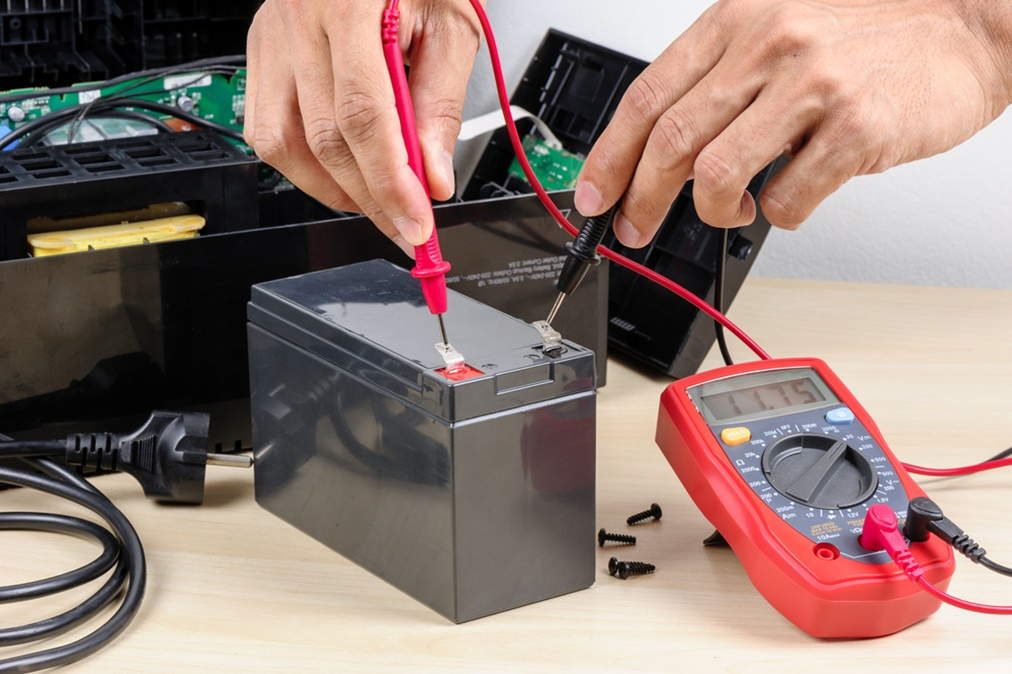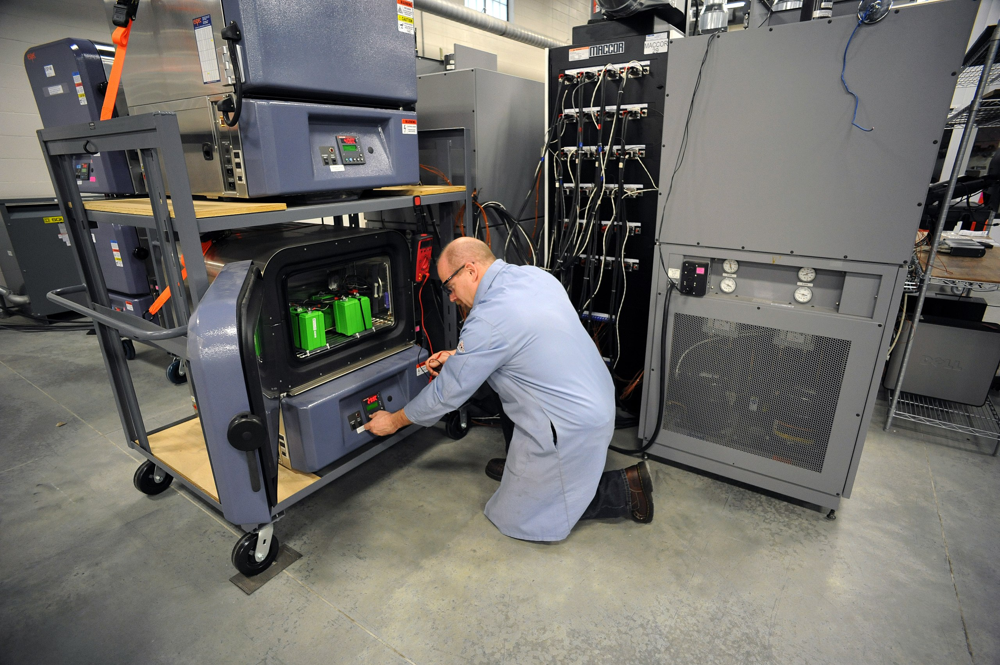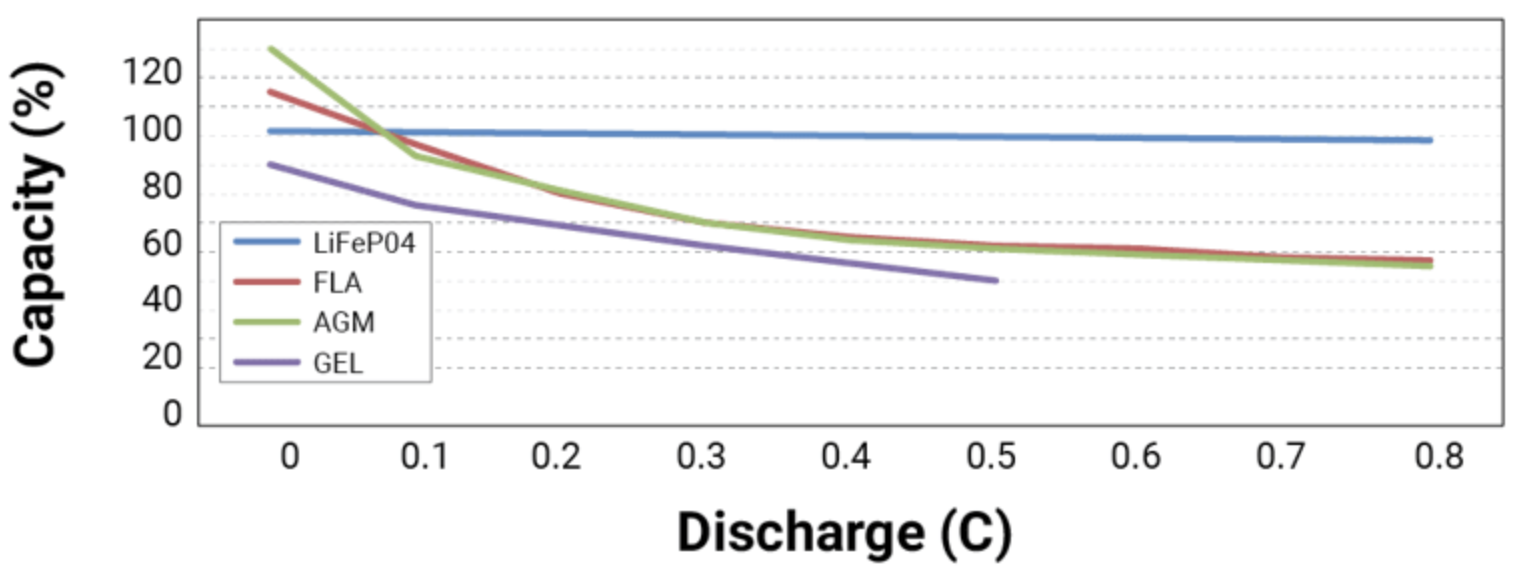การทดสอบโหลดแบตเตอรี่คืออะไร?
Battery load testing is a diagnostic method for evaluating a battery’s ability to deliver power under real-world operating conditions. It involves applying a controlled electrical load to the battery and observing how the battery’s แรงดันไฟและกระแสไฟขาออก respond. In essence, the test simulates the demands of actual usage – such as starting a car engine or powering a device – and checks whether the battery can maintain an adequate voltage when under load. This is a more stringent test than a simple open-circuit voltage check, since a battery can appear fully charged at rest but ไม่สามารถส่งมอบรันไทม์ตามที่คาดหวังภายใต้โหลดได้. By performing a load test, engineers and technicians can measure key performance indicators like the voltage drop and internal resistance (which reflects the battery’s capability to supply current). These indicators reveal the true health of the battery and help identify weak or aging batteries before they lead to failure in the field.

การทดสอบโหลดแบตเตอรี่ใช้กันอย่างแพร่หลายในอุตสาหกรรมต่างๆ ที่ความน่าเชื่อถือของแบตเตอรี่มีความสำคัญ ช่างยนต์จะทดสอบโหลดแบตเตอรี่รถยนต์ (โดยเฉพาะอย่างยิ่งในสถานการณ์สตาร์ทเครื่องยนต์ขณะเครื่องยนต์เย็น) เพื่อให้แน่ใจว่าแบตเตอรี่สามารถจ่ายกระแสไฟได้เพียงพอสำหรับการสตาร์ทเครื่องยนต์ ในระบบกักเก็บพลังงานหมุนเวียนและระบบไฟสำรอง การทดสอบโหลดจะยืนยันว่าแบตเตอรี่จะรองรับโหลดที่สำคัญในระหว่างที่ไฟฟ้าดับ ผู้ผลิต of batteries and devices also use load tests for quality control – to verify that new battery packs meet their specifications for capacity and output. In consumer electronics and industrial power systems, routine load testing helps catch performance issues early, preventing unexpected downtime or data loss due to a dying battery.
เหตุใดการทดสอบโหลดแบตเตอรี่จึงมีความสำคัญ?
การทดสอบโหลดแบตเตอรี่มีบทบาทสำคัญในการบำรุงรักษาแบตเตอรี่ ความปลอดภัย และการรับประกันประสิทธิภาพ เหตุผลสำคัญบางประการ ได้แก่:
- การควบคุมคุณภาพ (ผู้ผลิต): การทดสอบโหลดระหว่างการผลิตช่วยให้มั่นใจได้ว่าแบตเตอรี่เป็นไปตามข้อกำหนดการออกแบบและมาตรฐานคุณภาพ ช่วยตรวจจับข้อบกพร่องในการผลิตหรือความไม่สมดุลของเซลล์ได้ในระยะเริ่มต้น ป้องกันไม่ให้แบตเตอรี่คุณภาพต่ำเข้าสู่ตลาด ซึ่งช่วยปรับปรุงความน่าเชื่อถือของผลิตภัณฑ์โดยรวมและลดการเรียกร้องการรับประกัน
- ความน่าเชื่อถือสำหรับผู้ใช้ปลายทาง: For businesses and individuals who rely on batteries, load testing is crucial to verify that a battery will perform when it’s needed most. For example, backup power systems in telecom or data centers are routinely load-tested to validate battery capacity and runtime. This process can uncover weak cells or wiring issues ก่อน they cause unplanned downtime. By identifying a declining battery in an electric vehicle, solar storage bank, or UPS system, it can be replaced proactively – avoiding sudden failures and ensuring continuous operation.
- การเพิ่มประสิทธิภาพการทำงานและอายุการใช้งาน: Regular load testing helps in tracking a battery’s available capacity and internal resistance over time. By comparing test results against the battery’s rated capacity, users can determine when the battery has aged significantly. This information allows for optimized charging schedules and timely maintenance. Keeping batteries “exercise tested” under load can also prevent capacity loss from long periods of inactivity, thereby extending their usable lifespan.
- ความปลอดภัยและการปฏิบัติตาม: Faulty or deteriorating batteries can pose safety risks such as overheating, leakage, or in extreme cases (particularly with lithium-ion chemistries) thermal runaway. Load testing under controlled conditions can reveal these issues early, so that unsafe batteries are removed from service. Moreover, many industry standards and transportation regulations require rigorous battery testing. For instance, virtually all lithium-ion batteries must pass the UN 38.3 safety tests – a series of abuse and load conditions – to be certified for transport. Systematically load-testing battery systems helps ensure compliance with such standards and gives confidence that batteries can withstand the stresses of actual use.
หลักการทดสอบโหลดแบตเตอรี่
โดยพื้นฐานแล้ว การทดสอบโหลดแบตเตอรี่ทำงานบนหลักการง่ายๆ: apply a known load and measure the battery’s response. By observing how much the voltage drops under load and how well the battery sustains the load current, one can infer the battery’s internal condition. A healthy battery will maintain a higher voltage and recover quickly after the test, whereas a weak battery’s voltage will sag significantly under load and may struggle to recover afterward. The amount of voltage drop is directly related to the battery’s internal resistance – lower internal resistance means the battery can deliver higher current with less voltage drop.

ในระหว่างการทดสอบโหลด จะมีการตรวจสอบพารามิเตอร์ต่างๆ อย่างใกล้ชิด: แรงดันตก ข้ามแบตเตอรี่เมื่อมีการใช้โหลด ปัจจุบัน flowing, and often the battery’s อุณหภูมิ ระหว่างการทดสอบ แรงดันไฟตกอย่างมากหรือความร้อนที่เกิดขึ้นผิดปกติอาจบ่งชี้ถึงความต้านทานภายในที่เพิ่มขึ้นหรือความเสียหายของเซลล์ ในทางกลับกัน แบตเตอรี่ที่อยู่ในสภาพดีจะแสดงแรงดันไฟตกเพียงเล็กน้อยและความร้อนที่เกิดขึ้นเล็กน้อยสำหรับโหลดที่ระบุ
พฤติกรรมของแบตเตอรี่ภายใต้ภาระยังขึ้นอยู่กับคุณสมบัติทางเคมีและการออกแบบอีกด้วย แบตเตอรี่ประเภทต่างๆ จะมีลักษณะการคายประจุที่แตกต่างกัน ตัวอย่างเช่น แบตเตอรี่ตะกั่ว-กรดมีแนวโน้มที่จะแสดงแรงดันไฟฟ้าตกที่มากกว่าและสูญเสียความจุที่มีประสิทธิภาพเมื่ออัตราการคายประจุสูง ในขณะที่แบตเตอรี่ลิเธียมไอออน (โดยเฉพาะลิเธียมเหล็กฟอสเฟต LiFePO4) จะรักษาแรงดันไฟฟ้าที่เสถียรกว่าและจ่ายเปอร์เซ็นต์ความจุที่สูงกว่าแม้จะอยู่ภายใต้ภาระหนัก ซึ่งหมายความว่าแบตเตอรี่ลิเธียมโดยทั่วไปจะจัดการกับการดึงกระแสไฟฟ้าสูงได้ดีกว่าแบตเตอรี่ตะกั่ว-กรดที่มีค่าพิกัดเท่ากัน

การทำความเข้าใจความแตกต่างทางเคมีเหล่านี้ถือเป็นสิ่งสำคัญเมื่อตีความผลการทดสอบโหลด แรงดันไฟตกที่อาจเป็นปกติสำหรับแบตเตอรี่ประเภทหนึ่งอาจเป็นสัญญาณบ่งชี้ถึงปัญหาในแบตเตอรี่อีกประเภทหนึ่ง ในทำนองเดียวกัน เล็กน้อย การลดลงของความจุตามกาลเวลาอาจเกิดขึ้นได้สำหรับแบตเตอรี่ตะกั่ว-กรดที่ใช้งานหนัก ในขณะที่แบตเตอรี่ Li-ion ที่ได้รับการจัดการอย่างดีจะรักษาความจุส่วนใหญ่ไว้ได้แม้ผ่านรอบจำนวนเท่ากัน
อุณหภูมิ is another critical factor influencing load testing. Batteries perform best around room temperature, and both cold and hot conditions can skew test outcomes. In cold environments, a battery’s internal resistance increases and its ability to deliver current decreases – effectively reducing its available capacity. For instance, a battery that provides full capacity at about 27 °C (80 °F) might only deliver roughly 50% of its capacity at –18 °C (0 °F). Importantly, this capacity loss in the cold is usually ชั่วคราว: เมื่อแบตเตอรี่อุ่นขึ้นจนกลับมามีอุณหภูมิปกติ ประสิทธิภาพโดยทั่วไปของแบตเตอรี่ ฟื้นตัวกลับไปสู่ระดับเดิม. Because of this, load tests are usually conducted at standardized temperatures (around 20–25 °C, unless the goal is to specifically test cold/hot performance) to ensure the results reflect the battery’s true health rather than a transient thermal effect.
เพื่อให้ได้ข้อมูลที่แม่นยำและมีความหมาย การทดสอบโหลดจะปฏิบัติตามแนวทางปฏิบัติที่ดีที่สุด โดยทั่วไปแล้วแบตเตอรี่ ทดสอบเมื่อชาร์จเต็มแล้ว and in a rested state (no recent charging or discharging that could skew the voltage). The load applied should be chosen to mimic the battery’s real-world application – for example, drawing a high burst current to simulate a power tool or vehicle starter, or a steady lower current to simulate a device drain. The test is run for a defined duration long enough to observe the battery’s behavior (but usually short enough to avoid completely depleting the battery or causing undue stress). Throughout the test, conditions are kept controlled: the ambient temperature is kept stable, and the test equipment (load banks, meters, etc.) is สอบเทียบแล้ว for accuracy. Following these principles ensures that the load test results can be reliably compared to manufacturer specifications and previous test results, giving a clear picture of the battery’s state of health.
ประเภทการทดสอบโหลดแบตเตอรี่
การทดสอบโหลดแบตเตอรี่มีหลายประเภท แต่ละประเภทเหมาะกับวัตถุประสงค์และระบบแบตเตอรี่ที่แตกต่างกัน:
- การทดสอบโหลดกระแสคงที่: A steady, fixed current is drawn from the battery for a specified period. By measuring how the battery’s voltage declines over time under this constant load, one can assess its capacity and voltage stability. This is a common method to determine a battery’s true amp-hour capacity – for example, discharging at a 1 C rate (equal to the battery’s rated capacity) and seeing how long it sustains the load before reaching a cutoff voltage.
- การทดสอบโหลดชีพจร: The battery is subjected to intermittent high-current pulses separated by rest periods. This tests the battery’s response to sudden power demands. The voltage is monitored during each pulse to see how well it recovers in the brief rest. Pulse testing is often used to evaluate starting batteries or batteries in devices that periodically draw bursts of current. It can also help estimate internal resistance and dynamic performance without fully discharging the battery.
- การทดสอบความจุ (รันไทม์): โดยพื้นฐานแล้วนี่คือการทดสอบการปล่อยประจุจนเต็มที่มีการควบคุม แบตเตอรี่จะถูกปล่อยประจุในอัตราที่กำหนด (ซึ่งอาจเป็นกระแสคงที่หรือรูปแบบการใช้งานจำลอง) จนกระทั่งถึงค่าตัด (แรงดันไฟฟ้าขั้นต่ำที่ปลอดภัย) จากนั้นจะวัดเวลารวมหรือพลังงานทั้งหมดที่ส่งออก ซึ่งจะเผยให้เห็น ความจุที่ใช้ได้ ของแบตเตอรี่และให้การวัดระยะเวลาการทำงานโดยตรงภายใต้เงื่อนไขดังกล่าว การทดสอบดังกล่าวมีประโยชน์ในการตรวจสอบว่าแบตเตอรี่ยังคงเก็บประจุได้ตามที่คาดไว้หรือไม่ ตัวอย่างเช่น สตริงแบตเตอรี่ UPS อาจได้รับการทดสอบการคายประจุเพื่อให้แน่ใจว่าสามารถรองรับโหลดได้ตามระยะเวลาที่กำหนด (เช่น 30 นาที) ก่อนที่แรงดันไฟฟ้าจะลดลงจนเกินไป
- การทดสอบโหลดการหมุน: Used primarily for automotive and lead–acid starter batteries, this test measures the battery’s ability to deliver a very high current for a short duration (as needed to crank an engine). A specialized load tester or carbon pile applies a heavy load (hundreds of amps for a car battery) for 5–10 seconds while monitoring the voltage. The voltage should stay above a specified threshold (e.g. ~9.6 V for a 12 V battery at room temperature, higher if tested warm) during the crank simulation. A battery that cannot maintain voltage under this brief but intense load is likely failing, even if it reads 12 V in open-circuit. Cranking tests are often part of car battery diagnostics, especially in cold weather, to ensure reliable starts.
อุปกรณ์ทดสอบโหลดแบตเตอรี่
การทดสอบโหลดอย่างปลอดภัยและแม่นยำต้องใช้อุปกรณ์ที่เหมาะสม เครื่องมือและส่วนประกอบสำคัญ ได้แก่:
- เครื่องทดสอบโหลด / โหลดแบงค์: This is the device that actually puts a controlled load on the battery. Simple portable load testers for car batteries use a resistor or carbon pile to draw a high current. More advanced electronic load banks can be programmed to draw specific currents or profiles and often include built-in meters. The load tester typically measures the battery’s voltage under load, and some models also measure internal resistance and other metrics.
- มัลติมิเตอร์ หรือ โวลต์มิเตอร์ : A calibrated multimeter is used to independently measure the battery’s voltage and sometimes current during testing. This provides accurate readings and a sanity check against the load tester’s built-in measurements. In some cases, clamp ammeters are also used to verify the exact current being drawn.
- เครื่องบันทึกข้อมูล / เครื่องวิเคราะห์แบตเตอรี่: For more detailed testing (especially in research, manufacturing, or predictive maintenance), data acquisition devices record the battery’s voltage, current, and temperature throughout the load test. The resulting data can be analyzed to see how quickly the voltage declines, how stable the current draw remained, and if there were any irregular drops or recoveries. This is useful for comparing multiple batteries or tracking a battery’s performance over time.
- เซ็นเซอร์อุณหภูมิ: Because temperature greatly affects battery behavior, testers often monitor ambient and battery temperature. In critical testing, thermocouples might be attached to the battery to ensure it’s within the desired temperature range and to detect any dangerous overheating during the test.
- อุปกรณ์ด้านความปลอดภัย: การทดสอบโหลดอาจทำให้แบตเตอรี่เกิดความเครียด ดังนั้นความปลอดภัยจึงเป็นสิ่งสำคัญที่สุด ควรสวมอุปกรณ์ป้องกัน เช่น ถุงมือฉนวนและอุปกรณ์ป้องกันดวงตา โดยเฉพาะอย่างยิ่งกับแบตเตอรี่ขนาดใหญ่ที่อาจปล่อยประกายไฟหรืออิเล็กโทรไลต์ออกมาหากมีสิ่งผิดปกติเกิดขึ้น จำเป็นต้องมีการระบายอากาศที่เหมาะสมเมื่อทำการทดสอบแบตเตอรี่ตะกั่ว-กรด (ซึ่งอาจปล่อยก๊าซไฮโดรเจนออกมา) และควรมีอุปกรณ์ดับเพลิงไว้ในมือเมื่อทำการทดสอบแบตเตอรี่ลิเธียมพลังงานสูง นอกจากนี้ การใช้สายไฟและที่หนีบที่มีอัตราพิกัดที่ถูกต้องสำหรับโหลดก็มีความสำคัญเช่นกัน เพื่อป้องกันไม่ให้แบตเตอรี่ร้อนเกินไปในระหว่างการทดสอบกระแสไฟสูง
กระบวนการทดสอบโหลดแบตเตอรี่
When you are ready to conduct a battery load test, it’s important to follow a structured process:
- การตระเตรียม: Begin with a fully charged battery. Make sure the battery has been rested for a while after charging so that the voltage has stabilized (surface charge dissipated). Check the ambient conditions – ideally, test in a room-temperature environment unless you are specifically evaluating cold or hot performance. Gather all required equipment (load tester, multimeter, etc.), and put on appropriate safety gear. Also, review the battery’s specifications to know what load and voltage values to expect (for example, maximum test current or minimum allowable voltage).
- การเชื่อมต่ออุปกรณ์: Turn off or set the load tester to zero before connecting. Attach the load tester’s leads to the battery terminals: positive (+) to positive, negative (–) to negative, ensuring solid connections. If using a separate voltmeter or data logger, connect those probes or sensors to the battery as well. Double-check all connections are secure to avoid arcing when the test begins.
- ตั้งค่าพารามิเตอร์การโหลด: Configure the load tester to the desired load. This could mean dialing in a certain current (e.g. a 50 A draw for a small battery, or a 300 A draw for a car battery test), or selecting a specific test mode on an electronic load (constant current, pulse, etc.). Refer to the battery’s ratings or the relevant standard for guidance – for instance, use a load equal to half the battery’s CCA rating for an automotive load test, or a 0.2 C (5-hour rate) load for a capacity test, depending on the goal.
- ดำเนินการทดสอบ: เปิดใช้งานเครื่องทดสอบโหลดเพื่อเริ่มดึงกระแสไฟจากแบตเตอรี่ ให้โหลดทำงานตามระยะเวลาที่กำหนด อาจใช้เวลาเพียงไม่กี่วินาทีสำหรับการทดสอบกระแสไฟสูง หรืออาจใช้เวลาหลายนาทีหรือหลายชั่วโมงสำหรับการทดสอบการคายประจุแบบขยายเวลา (ในกรณีนี้ ให้ตรวจสอบว่าโหลดคงที่หรือปฏิบัติตามโปรไฟล์ที่กำหนด) Monitor the battery’s behavior throughout. Observe the voltage reading – a sharp drop initially is normal, but it should stabilize above the minimum acceptable voltage. Watch for any signs of distress such as the battery overheating, smoking, or emitting unusual odors (if so, terminate the test immediately). If using a data logger, ensure it’s recording properly.
- ติดตามและวิเคราะห์ผลลัพธ์: Once the test interval is completed, remove or turn off the load. Continue to watch the battery’s voltage recovery for a minute or two. Note the loaded voltage and the recovery voltage. Now analyze the data: Did the battery maintain voltage above the cutoff threshold during the test? How much capacity (Ah or minutes of runtime) was delivered in a full discharge test? Compare these outcomes to the battery’s rated specifications or to previous test results. A healthy battery should meet or come close to its specs (e.g. delivering its rated amp-hours, or keeping above the minimum voltage under load). If the battery’s performance falls short, it may indicate aging or damage. Use this information to decide on next steps – for example, keep the battery in service with a scheduled re-test later, or retire/replace the battery if it failed to perform.
การตีความผลการทดสอบโหลด
การทำความเข้าใจผลลัพธ์ของการทดสอบโหลดแบตเตอรี่มีความสำคัญพอๆ กับการทำการทดสอบจริง ต่อไปนี้คือประเด็นสำคัญที่ต้องพิจารณาเมื่อตีความผลลัพธ์:
- การตอบสนองแรงดันไฟฟ้า: Observe how the battery’s voltage behaved under load. A แรงดันไฟฟ้าคงที่ that stays within expected limits indicates a healthy battery with low internal resistance. If the voltage dropped significantly (below the recommended cutoff for that battery type), that’s a red flag. For instance, if a 12 V battery falls well below ~10 V under a moderate load, it likely cannot supply the required current or has substantially lost capacity. Also, note the recovery voltage after the load is removed – a healthy battery’s voltage will bounce back close to its normal resting value, whereas a weak battery may recover only partially or very slowly.
- ความจุและระยะเวลาการทำงาน: หากการทดสอบโหลดเป็นการคายประจุแบบกำหนดเวลา (เช่น การทดสอบ 2 ชั่วโมงด้วยกระแสไฟคงที่) ให้ใช้ข้อมูลเพื่อคำนวณความจุที่มีประสิทธิภาพ เปรียบเทียบ ความจุที่วัดได้ (or runtime) to the battery’s rated capacity. A significantly lower capacity (e.g. a battery rated for 100 Ah only delivered 60 Ah before hitting cutoff) suggests the battery has aged or deteriorated. Many organizations use an 80% rule of thumb – if a rechargeable battery’s tested capacity falls below ~80% of its original rating, the battery is considered at end-of-life and should be replaced to ensure reliability.
- ความต้านทานภายในและแรงดันตก: From the voltage and current data, you can infer the battery’s internal resistance (Ohm’s law: ΔV = I * R_internal). An increasing internal resistance over successive tests is a sign of aging. High internal resistance will cause excessive voltage drop even at moderate loads, leading to poor performance. Some battery testers measure this directly. If you see that even small loads cause a notable voltage dip, the battery likely has a high internal impedance and may fail under heavier loads.
- อุณหภูมิและความผิดปกติอื่นๆ: If you recorded temperature, assess whether the battery was heating significantly under load. A rise in temperature during a short test can indicate inefficiencies (energy lost as heat due to internal resistance) or internal cell damage. Any signs of swelling, venting, or leakage observed during or after the test are indicators of a failing battery and a serious reason to remove it from service. In a properly functioning battery, temperature should remain within normal limits for the test’s duration (most of the battery’s energy should be going into the load, not heating the battery itself).
- แนวโน้มในช่วงเวลา: One load test provides a snapshot, but multiple tests over a battery’s life can illustrate trends. Keep records of each battery’s test results. If you notice, for example, that each quarterly test shows the voltage under load dropping lower than the last time, or the delivered capacity decreasing gradually, you have a quantified record of the battery’s degradation. This trend analysis allows for predictive maintenance – you can plan to replace batteries ก่อน ล้มเหลวโดยสิ้นเชิง ในการติดตั้งแบตเตอรี่ขนาดใหญ่ (เช่น ระบบ UPS ของศูนย์ข้อมูลหรือธนาคารเก็บพลังงานแสงอาทิตย์) การติดตามแนวโน้มเหล่านี้สำหรับแต่ละหน่วยจะช่วยให้มั่นใจได้ว่าธนาคารแบตเตอรี่ทั้งหมดยังคงเชื่อถือได้โดยเปลี่ยนหน่วยที่อ่อนแอในเวลาที่เหมาะสม
By combining all these observations, you can make an informed judgment about the battery’s health. A good outcome (voltage stable, capacity on target, no excessive heat) means the battery is fit for continued use. Any poor results should prompt further action – perhaps recondition or balance the battery if possible, or retire the battery and replace it to maintain system reliability. Remember that ความปลอดภัยมาเป็นอันดับแรก: if a battery shows severe problems (can’t hold voltage, overheats, etc.), remove it from service, as those issues can escalate to complete failure or safety hazards under continued use.
บทสรุป
Battery load testing is an essential practice for anyone who depends on reliable battery power. By applying realistic loads and scrutinizing how a battery performs, this test provides invaluable insight into the battery’s true state of health that simple voltage readings can’t offer. Regular load testing helps manufacturers ensure product quality and helps users avoid unexpected battery failures by catching early warning signs of degradation. In applications ranging from automobiles to backup power systems, load testing underpins both การเพิ่มประสิทธิภาพการทำงานและความปลอดภัย, verifying that each battery can meet the demands placed on it. By understanding and implementing proper load testing – following the principles, using the right equipment, and interpreting the results wisely – one can extend battery life, plan timely maintenance, and ensure that critical battery-powered systems remain up and running when they’re needed most.


